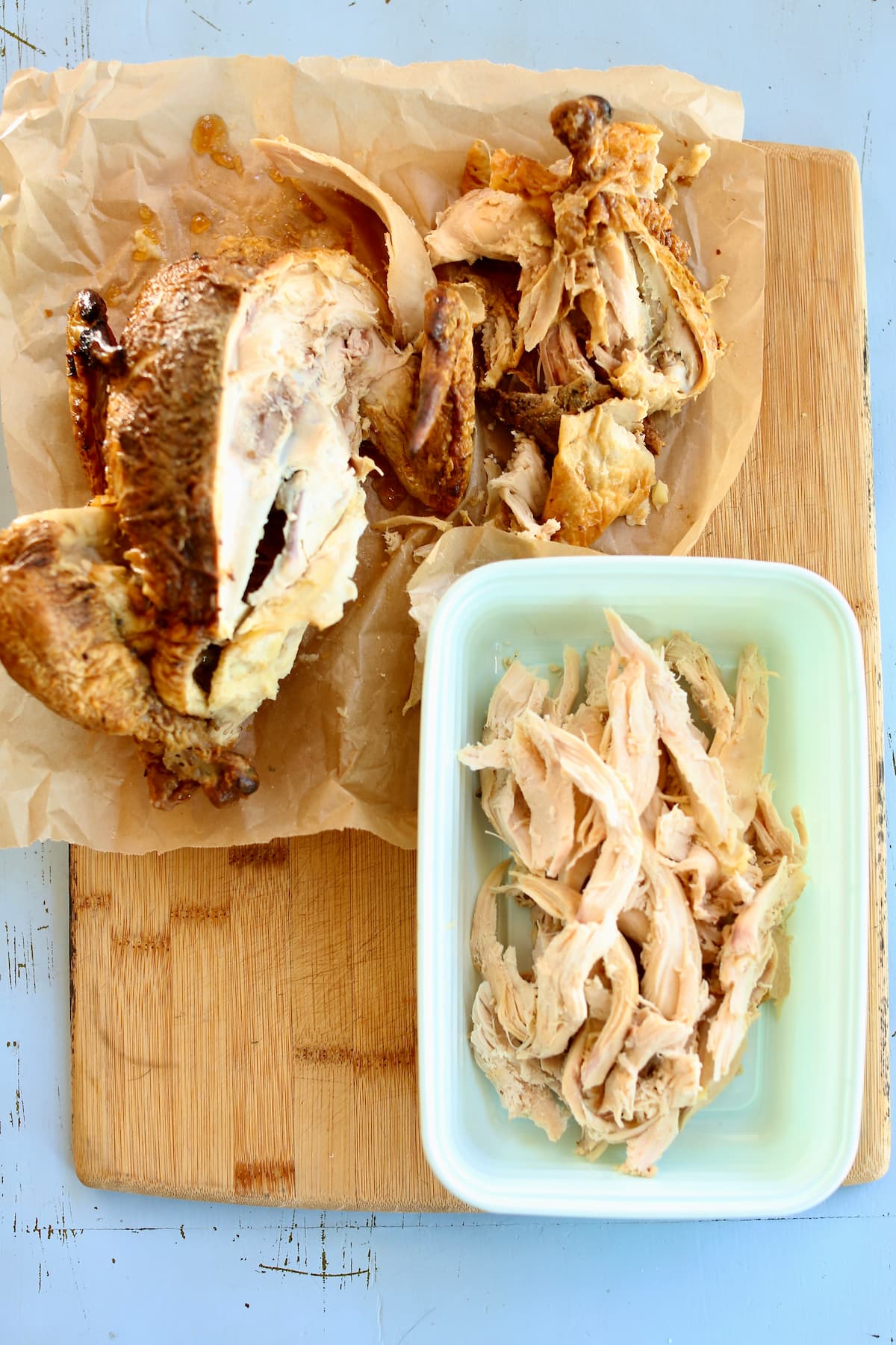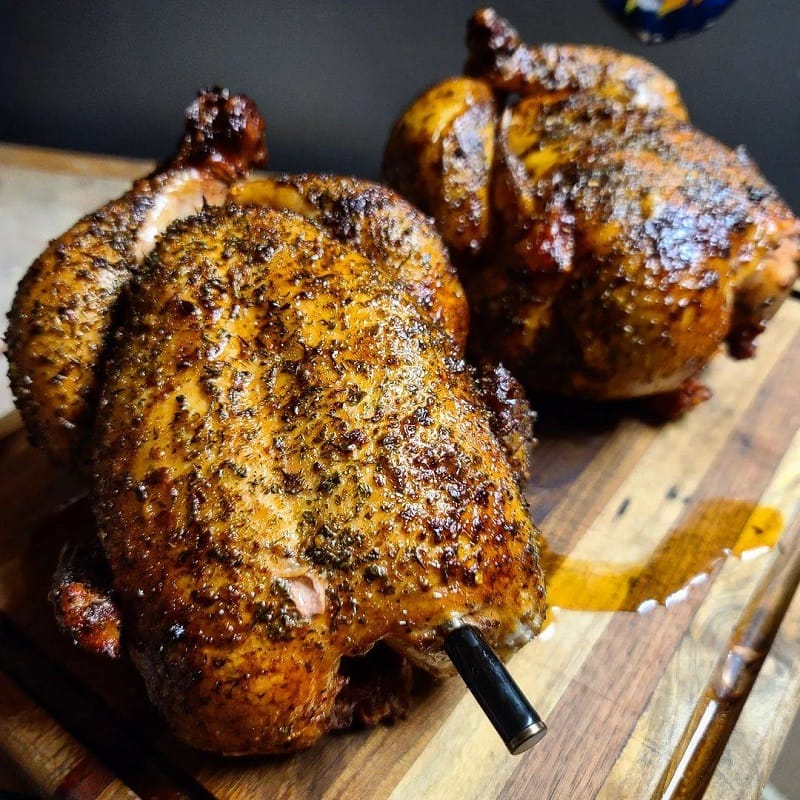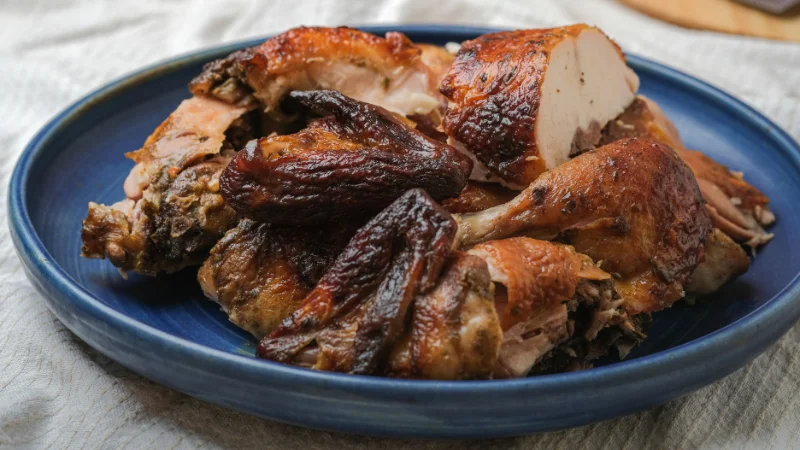What Is Rotisserie Chicken?

Rotisserie chicken is a popular food item that is cooked using a rotisserie, a method of cooking where the chicken is skewered and rotated over a heat source. This cooking technique helps to evenly cook the chicken, resulting in moist and flavorful meat with a crispy skin. Rotisserie chicken is often seasoned with spices or marinated to enhance its taste. It is commonly sold as a convenient and ready-to-eat option in grocery stores and delis. The popularity of rotisserie chicken lies in its convenience, delicious flavor, and versatility in various dishes.
The Process Of Cooking Rotisserie Chicken
To cook rotisserie chicken, the chicken is skewered and rotated over a heat source. The chicken is often seasoned with spices or marinated to enhance its flavor. As it rotates, the heat source evenly cooks the chicken, resulting in moist and flavorful meat with a crispy skin. The cooking process helps to seal in the juices, creating a delicious and succulent chicken. This method is commonly used in grocery stores and delis to prepare ready-to-eat rotisserie chickens that are convenient for customers. The rotisserie cooking technique ensures a delicious and evenly cooked chicken every time.
Nutritional Value Of Rotisserie Chicken
Rotisserie chicken is not only delicious but also packed with nutritional value. It is a good source of lean protein, which is essential for muscle growth and repair. Additionally, rotisserie chicken contains important minerals such as iron, zinc, and phosphorus, which are necessary for various bodily functions. It also provides vitamins like B6 and B12, which are essential for energy production and maintaining a healthy nervous system. However, it’s important to keep in mind that the nutritional content may vary depending on the seasoning or marinade used, so it’s always a good idea to check the label for specific information. So, enjoy your rotisserie chicken knowing that it offers both taste and nutrition.
How Long Can You Keep Rotisserie Chicken?

After purchasing or cooking rotisserie chicken, it’s important to know how long it can be safely stored. When properly stored in the refrigerator at a temperature below 40°F (4°C), rotisserie chicken can be kept for 3-4 days. However, if you’re unable to consume it within that time frame, it’s best to freeze it. When stored in the freezer at 0°F (-18°C) or below, rotisserie chicken can be kept for up to 4 months. It’s important to note that these storage times are general guidelines and can vary based on factors like the freshness of the chicken and how it was handled after cooking.
Factors That Affect The Shelf Life Of Rotisserie Chicken
The shelf life of rotisserie chicken can be influenced by several factors. These include:
- Initial Quality: The quality of the chicken when it was cooked plays a significant role in determining its shelf life. Fresh, high-quality chicken will generally last longer than chicken that was not as fresh or of lower quality.
- Storage Conditions: Proper storage is crucial in prolonging the shelf life of rotisserie chicken. It should be kept at a temperature below 40°F (4°C) in the refrigerator to slow down bacterial growth.
- Handling: The way the chicken is handled after cooking can affect its shelf life. It’s important to use clean utensils and containers to prevent contamination.
- Time: The longer the chicken is stored, the higher the risk of spoilage. It’s recommended to consume rotisserie chicken within 3-4 days to ensure its freshness and safety.
By considering these factors and following the recommended storage practices, you can maximize the shelf life of your rotisserie chicken and enjoy it safely.
Recommended Storage Time For Rotisserie Chicken
The recommended storage time for rotisserie chicken is 3-4 days when stored in the refrigerator. It is important to consume the chicken within this timeframe to ensure its freshness and safety. After 4 days, the risk of bacterial growth and spoilage increases significantly. If you are unable to consume the chicken within this period, it is advisable to freeze it for longer storage. When frozen, rotisserie chicken can last for up to 4 months. Remember to label and date the chicken before freezing and thaw it properly before consuming.
Signs Of Spoiled Rotisserie Chicken

When rotisserie chicken goes bad, there are clear signs to look out for. Physically, if you notice any visible mold, discoloration, or slimy texture on the chicken, it is a sure indicator of spoilage. The smell of the chicken also changes when it spoils, emitting a foul odor. In terms of texture, if the chicken feels excessively dry or sticky, it is no longer safe to eat. To ensure food safety, it is important to recognize these signs and discard any rotisserie chicken that shows these signs of spoilage.
Physical Signs Of Spoilage
Physical signs of spoilage in rotisserie chicken include visible mold, discoloration, and a slimy texture on the chicken. Mold can appear as green or black spots on the surface of the chicken, indicating bacterial growth. Discoloration can range from a brown or yellowish tint to gray or green patches. A slimy or sticky texture is a clear indication that the chicken has gone bad. These physical signs serve as warning signs and should not be ignored. If any of these signs are present, it is best to discard the chicken to prevent foodborne illnesses.
Odor And Texture Changes In Spoiled Rotisserie Chicken
Spoiled rotisserie chicken can exhibit distinct odor and texture changes, which are clear indicators that it is no longer safe to consume. The chicken may emit a strong, unpleasant smell that is different from its usual aroma. Additionally, the texture of the chicken can become slimy or sticky, indicating bacterial growth and spoilage. These changes in odor and texture are important warning signs that the chicken has gone bad and should be discarded immediately to avoid the risk of foodborne illnesses.
Tips For Storing Leftover Rotisserie Chicken

To properly store leftover rotisserie chicken, it is important to follow a few tips to maintain its freshness. First, remove the chicken from the bones and transfer it to an airtight container or wrap it tightly in plastic wrap or aluminum foil. Store it in the refrigerator, where it can last for an additional 3-4 days. Alternatively, you can freeze the chicken for longer storage, up to 4 months. Label the container with the date to keep track of its freshness. Always remember to reheat the chicken thoroughly before consuming.
Proper Storage Containers And Methods
When storing leftover rotisserie chicken, it is important to use proper storage containers and methods to maintain its freshness. Opt for airtight containers or sealed zip-top bags to prevent moisture and air from reaching the chicken, which can cause it to spoil more quickly. Make sure to remove the chicken from the bones and ensure there are no bones remaining to prevent any potential hazards. Additionally, label the container with the date to keep track of its freshness. Store the container in the refrigerator for up to 3-4 days or freeze for longer storage.
Best Practices For Reheating
When reheating rotisserie chicken, it is important to follow best practices to ensure food safety. Here are some tips:
- Use the oven or stovetop: Reheating in the oven or on the stovetop is preferable to using the microwave, as it allows for more even heating.
- Reheat to a safe temperature: Make sure to heat the chicken to an internal temperature of 165°F (74°C) to kill any bacteria and ensure it is safe to consume.
- Add moisture: If the chicken appears dry, drizzle it with some chicken broth or water before reheating to help maintain its moisture.
- Divide into smaller portions: If reheating a large amount of leftover chicken, divide it into smaller portions to ensure it heats evenly and thoroughly.
By following these best practices, you can enjoy reheated rotisserie chicken that is both delicious and safe to eat.
Food Safety Concerns With Rotisserie Chicken

Rotisserie chicken can pose food safety concerns if not handled and stored properly. Bacteria, such as Salmonella and Campylobacter, can contaminate the chicken during processing or if it is left at unsafe temperatures for too long. These bacteria can cause foodborne illnesses if consumed. To prevent contamination, it is important to follow proper hygiene practices when handling and storing rotisserie chicken. This includes using separate dishes or containers for raw and cooked chicken, washing hands thoroughly after handling raw chicken, and refrigerating or freezing leftovers promptly. By practicing good food safety habits, you can enjoy delicious and safe rotisserie chicken.
Bacteria And Foodborne Illnesses Associated With Rotisserie Chicken
Rotisserie chicken can harbor harmful bacteria such as Salmonella and Campylobacter, which can cause foodborne illnesses. These bacteria can contaminate the chicken during processing or if it is not stored at safe temperatures. Consuming rotisserie chicken that is contaminated can lead to symptoms like diarrhea, vomiting, and stomach cramps. It is crucial to handle and store rotisserie chicken properly to prevent bacterial growth. This includes avoiding cross-contamination, cooking the chicken to the appropriate temperature, and refrigerating or freezing leftovers promptly. Practicing good food safety habits is essential to protect yourself from these bacteria and enjoy rotisserie chicken safely.
Precautions To Prevent Contamination
To prevent contamination, it is essential to take proper precautions when handling rotisserie chicken. Here are some important steps to follow:
- Separate raw and cooked chicken: Use separate dishes or containers for raw and cooked chicken to avoid cross-contamination.
- Clean and sanitize: Thoroughly clean and sanitize all surfaces, utensils, and cutting boards that come into contact with raw chicken to prevent the spread of bacteria.
- Wash hands: After handling raw chicken, wash your hands with soap and water for at least 20 seconds to eliminate any potential bacteria.
- Store properly: Refrigerate or freeze leftover rotisserie chicken promptly to prevent bacterial growth. Keep it in airtight containers or wrap it tightly in plastic wrap to maintain freshness.
- Cook thoroughly: Ensure that the chicken is cooked to the appropriate internal temperature (165°F or 74°C) to kill any bacteria that may be present.
By following these precautions, you can minimize the risk of contamination and enjoy rotisserie chicken safely.
Conclusion

In conclusion, rotisserie chicken can be a delicious and convenient meal option. However, it is important to prioritize food safety when handling and storing it. Proper storage, reheating, and handling techniques can help extend the shelf life of rotisserie chicken and minimize the risk of foodborne illnesses. By following the recommended storage time, being aware of signs of spoilage, and taking precautions to prevent contamination, you can enjoy rotisserie chicken safely. Remember to always trust your senses and discard any chicken that appears or smells spoiled.
Summary Of Food Safety Tips For Handling And Storing Rotisserie Chicken
When it comes to handling and storing rotisserie chicken, there are a few key food safety tips to keep in mind. First, make sure to refrigerate the chicken within two hours of purchase or cooking to prevent bacterial growth. Store the chicken in a clean, airtight container or Zip-loc bag to maintain freshness and prevent cross-contamination. When reheating, ensure that the chicken reaches a temperature of at least 165°F (74°C) to kill any bacteria. Lastly, always trust your senses and discard any chicken that looks or smells spoiled. Following these guidelines will help ensure the safety and deliciousness of your rotisserie chicken meals.
Common Misconceptions And Final Thoughts
There are a few common misconceptions surrounding rotisserie chicken that it’s important to address. One misconception is that you can determine the freshness of rotisserie chicken based solely on its appearance. However, while visual cues can be helpful, they’re not always reliable indicators of spoilage. It’s crucial to follow proper storage and handling guidelines to ensure the safety of the chicken.
In conclusion, rotisserie chicken can be a convenient and delicious option when stored and handled correctly. By being mindful of the recommended storage times, reheating temperatures, and signs of spoilage, you can enjoy rotisserie chicken safely and confidently. Remember, when in doubt, it’s always better to err on the side of caution and discard any chicken that you suspect may be spoiled.
FAQ: How Long is Rotisserie Chicken Good For?
Q: How long can I keep rotisserie chicken in the refrigerator?
A: Generally, it is safe to refrigerate rotisserie chicken for up to 4 days. This time frame ensures the chicken stays fresh and doesn’t pose a risk of foodborne illness.
Q: Can I freeze rotisserie chicken?
A: Yes, you can freeze rotisserie chicken. If you plan to consume it later, it is best to freeze it within a day of purchasing or cooking. Make sure to store it in an airtight container or freezer bag, and it can last for up to 4 months in the freezer.
Q: How can I tell if rotisserie chicken has gone bad?
A: There are a few signs to watch out for to determine if rotisserie chicken has spoiled. These include a sour or unpleasant smell, slimy texture, mold growth, or any visible signs of discoloration. If you are in doubt, it is better to discard it and prioritize your safety.
Q: Can I reheat rotisserie chicken?
A: Absolutely! To reheat rotisserie chicken, ensure it is heated thoroughly to an internal temperature of 165°F (74°C). You can use an oven, microwave, or stovetop for reheating, but make sure it is piping hot before consumption.
Q: How long can I keep rotisserie chicken at room temperature?
A: It is not recommended to leave rotisserie chicken at room temperature for more than 2 hours. Bacteria can grow rapidly at room temperature, increasing the risk of foodborne illness. Always refrigerate or freeze it promptly after purchase or cooking.
Q: Can I use leftover rotisserie chicken for salads or sandwiches?
A: Absolutely! Leftover rotisserie chicken is perfect for making salads, sandwiches, wraps, or adding it to various recipes. Just ensure that it has been stored properly and is within the safe storage time limit.
Q: Is it safe to consume rotisserie chicken that has been sitting out overnight?
A: It is generally not recommended to consume rotisserie chicken that has been left out overnight. Bacteria can multiply rapidly at room temperature, increasing the risk of foodborne illnesses. It’s safer to discard it to avoid any potential health risks.
Q: Can I use rotisserie chicken in recipes after the recommended storage time?
A: It is best to use rotisserie chicken within the recommended storage time for optimal freshness and safety. While it may still be safe to consume after this time, the quality may deteriorate, and there is an increased risk of foodborne illness. It’s always better to prioritize food safety and discard if unsure.
Remember, these guidelines are general recommendations, and it’s essential to use your judgment and senses when determining if rotisserie chicken is still good to eat.

Frog Bear & Wild Boar is a vibrant and dynamic establishment located at 343 N Front St. in the heart of the Arena District in Columbus, OH. Our story began with a passion for creating an inviting and lively environment where friends, families, and colleagues can come together to enjoy great food, refreshing drinks, and fantastic entertainment. Founded on the principles of warm hospitality, delicious cuisine, and a commitment to community, Frog Bear & Wild Boar has become a beloved gathering place for locals and visitors alike. Our dedication to delivering exceptional experiences has earned us a reputation for being a go-to destination for memorable outings and special occasions.